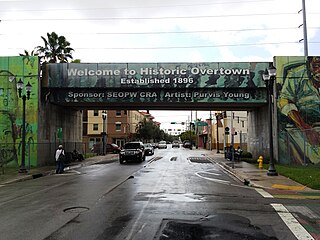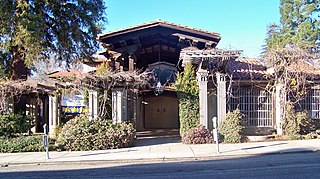
The First Church of Christ, Scientist is the administrative headquarters and mother church of the Church of Christ, Scientist, also known as the Christian Science church. Christian Science was founded in the 19th century in Lynn, Massachusetts, by Mary Baker Eddy with the publication of her book Science and Health (1875).

Overtown is a neighborhood of Miami, Florida, United States, just northwest of Downtown Miami. Originally called Colored Town during the Jim Crow era of the late 19th through the mid-20th century, the area was once the preeminent and is the historic center for commerce in the black community in Miami and South Florida.

The Gold Dome, a geodesic dome in Oklahoma City, Oklahoma, is a landmark on Route 66. It was built in 1958 and is located at the intersection of NW 23rd Street and North Classen Boulevard. It was declared eligible to be listed in the National Register of Historic Places in 2002.

The Christian Science Center is a 13.5-acre (5.5 ha) site on the corner of Massachusetts Avenue and Huntington Avenue in the Fenway neighborhood of Boston, Massachusetts. A popular tourist attraction, the center is owned by the Church of Christ, Scientist, which refers to it as Christian Science Plaza. The complex, including most of the landscape was designated as a Boston Landmark by the Boston Landmarks Commission in 2011.

First Church of Christ, Scientist, Berkeley, now also known as Christian Science Society, Berkeley, is a Christian Science church, located at 2619 Dwight Way at Bowditch Street across the street from People's Park, in the South Berkeley neighborhood of Berkeley, in Alameda County, California.

The former First Church of Christ, Scientist, now the Little Rock Community Church, is a historic church building at 2000 South Louisiana Street in Little Rock, Arkansas. It is a single-story Mission style building, designed by noted Arkansas architect John Parks Almand and completed in 1919. Characteristics of the Mission style include the low-pitch tile hip roof, overhanging eaves with exposed rafter ends, and smooth plaster walls. The building also has modest Classical features, found in pilaster capitals and medallions of plaster and terra cotta. The building is local significant for its architecture. It was built for the local Christian Science congregation, which in 1950 sold it to an Evangelical Methodist congregation. That congregation has since severed its association with the Evangelical Methodist movement, and is now known as the Little Rock Community Church.

The First Church of Christ, Scientist, now known as Lackawanna County Children's Library, is a building in Scranton, Pennsylvania located at 520 Vine Street. The building was added to the National Register of Historic Places on May 9, 1988. The building, built in 1915, was listed for its Classical Revival architecture.

The former First Church of Christ, Scientist, built in 1909, is an historic building located at 1813 NW Everett Street, in Portland, Oregon. It was designed by noted Chicago architect Solon Spencer Beman, who designed many Christian Science churches. On October 2, 1978, the building was added to the National Register of Historic Places.

The Robert Simpson Woodward House is a former residence located at 1513 16th Street, NW in the Dupont Circle neighborhood of Washington, D.C. From 1904 until 1914, it was a home of geologist Robert Simpson Woodward (1849–1924), the first president of the Carnegie Institution and a highly regarded scientist and science administrator. The building currently serves as the Capital Research Center headquarters. It was declared a National Historic Landmark in 1976 and designated a contributing property to the Sixteenth Street Historic District in 1978.

The Sixteenth Street Historic District is a 1.25 mile linear historic district in Washington, D.C. that includes all structures along 16th Street NW between H Street and Florida Avenue. The district's southern boundary is bordered by Lafayette Square, just north of the White House, and Meridian Hill Park on its northern boundary. It includes an eclectic mix of architectural styles on one of the city's most historic and important numbered streets including single and multi-family residential buildings, embassies, hotels, churches, and office buildings. Most of the district's oldest structures are religious and residential buildings, while many of the commercial buildings were built in the early to mid-20th century. The stretch of 16th Street between Scott Circle and Florida Avenue was recognized as a historic district in 1978 and listed on the National Register of Historic Places, and in 2007 it was expanded to include buildings south of Scott Circle to H Street. The historic district is also listed on the District of Columbia Inventory of Historic Sites.

The former Seventh Church of Christ, Scientist, building is located in the Queen Anne Hill neighborhood of Seattle, Washington, is an historic Christian Science church edifice. Built in 1926, it was designed by noted Seattle architect Harlan Thomas in the Neo-Byzantine, Mission Revival and Spanish Colonial styles. It consists of two parts joined together to form an ell: the 2-story main section containing the church auditorium and a one-story wing containing the Sunday School. The main section is square but each corner has been "flattened to form an irregular octagon.

Fifth Church of Christ, Scientist is an historic Classical Revival-style Christian Science church building located at 9 East 43rd Street near Madison Avenue and Grand Central Terminal in Manhattan, New York City. Built in 1921 on the former site of St. Bartholomew's Episcopal Church. Fifth Church of Christ, Scientist, is unusual in that it occupies part of the first two stories of a 21-story office building that was originally named the Canadian Pacific Building. The church auditorium seats 1800 people.

The former First Church of Christ, Scientist, is an historic Christian Science church building located at 700 22nd Street, Rock Island, Illinois, United States. Designed by architect William C. Jones of Chicago in the Palladian style, it was built between 1914-1915. Its exterior walls are of brick covered by Bedford limestone. Its superimposed front portico is supported by six 2 story columns with egg-and-dart capitals. Its dome actually consists of 2 domes: an outer dome and an inner dome which are separated by a space for lighting fixtures and maintenance. The inner dome consists of some 8,000 colored fish scale glass panes on a wooden support structure. The inner dome is similar to the inner dome of First Church of Christ, Scientist in Kalamazoo, Michigan, which was designed by William C. Jones in 1913.

First Church of Christ, Scientist Building is an historic Christian Science church located at 1519 East Denny Way / 1841 16th Avenue on the corner of East Denny Way and 16th Avenue in the Capitol Hill neighborhood of Seattle, Washington. Designed in the Classical Revival style, it was built of Bedford limestone between 1906 and 1909. Established in August 1896, First Church first held services in various rented buildings or halls until building its first church building on the corner of 6th Avenue and Marion Street. This was completed in time for its first service on Easter Sunday, April 7, 1901. This was soon outgrown and in November 1906 a contract was signed to purchase the Denny Way property. In August 1908, services began in a temporary wooden structure that was built on the completed foundation of the new church. On January 17, 1977 the building was declared a City of Seattle historic landmark. In 2006 the congregation made the decision to move to the South Lake Union neighborhood to be in a more active urban location. The building on East Denny Way was sold to a developer who has since converted it into townhouse project called The Sanctuary. First Church of Christ, Scientist, Seattle, now holds services at 900 Thomas Street and is still an active branch of the Christian Science Mother Church.

The former Sixth Church of Christ, Scientist is an historic Christian Science church edifice located at 2656 42nd Avenue, Southwest, in the Admiral District of West Seattle in Seattle, Washington. Built in 1929 by contractor Neil McDonald, it was designed by Seattle architect Gerald C. Field in the Art Deco style of architecture. Sixth Church, which had been incorporated in 1919, declined in membership in the latter part of the 20th century, so in 2002, it decided to sell its building and merge with Fourteenth Church of Christ, Scientist. The building is listed as a Seattle Landmark. The building is now the Sanctuary at Admiral and is a venue for weddings and banquets.

The Orange Street Presbyterian Church, today the First Church of Christ Scientist, is a historic church building at 428 Orange Street in Hot Springs, Arkansas. It is a single-story brick structure, with a gable roof and concrete foundation. The front facade has a four-column Greek temple portico, with Ionic columns and a fully pedimented gable with an oculus vent at its center. The church was built in 1913 by a Presbyterian congregation founded in 1903. It was the congregation's third church, the first two succumbing to fire, and indebting the organization. It occupied the building until 1961, when it moved to new quarters, selling this building to the local Christian Science congregation. The building is one of Hot Springs' best examples of Classical Revival architecture.

Araldo Cossutta was an architect who worked primarily in the United States. From 1956 to 1973 he worked at the firm I. M. Pei & Partners. I. M. Pei has been among the most honored architects in the world. Cossutta was Pei's associate and ultimately his partner in the first phase of Pei's career. He was responsible for some of the firm's best-known designs from that era, including three that have received "landmark" designations in recent years. In 1973 he and Vincent Ponte left Pei's firm to form Cossutta & Ponte, which ultimately became Cossutta and Associates. The new firm designed the Credit Lyonnais Tower in Lyon, France (1977) and the Tower at Cityplace (1988) in Dallas, Texas, among other commissions.

The First Church of Christ, Scientist in Manhattan is a 1903 building located at Central Park West and 96th Street in the Upper West Side of Manhattan, New York City. The building is a designated New York City landmark.

The former First Church of Christ, Scientist, also known as The City Church, is located in Cedar Rapids, Iowa, United States. Christian Science began in Boston in 1866 and it was introduced to Cedar Rapids twenty years later. A Sunday School was established in 1887 and it met at the old Dows Auditorium at Third Avenue and Third Street SE. The congregation was established in 1891 as an official branch of The First Church of Christ, Scientist in Boston. It was the first Christian Science congregation established in Iowa. They held their Wednesday evening services at the Peoples Unitarian Universalist Church. The congregation began construction on this building in 1914 and it was dedicated on Easter Sunday the following year. It is a red brick structure in the Neoclassical style. The rectangular building features a portico with four columns in the Doric order on the main facade, and a centered raised gable roof with cornice returns. The architectural style was chosen to "attract non-churchgoing people that may be intimidated by traditional religious structures." The congregation has subsequently moved to a new facility on Blairs Ferry Road, NE. This building was listed on the National Register of Historic Places in 2017.





















